- Home
- Injections
- Laser Treatments
- Specialties
Specialtiesview all
- Other Treatments
- Before After Photos
Before After Photosview all
- Contact Us
- Doctor And Staff
- About Celibre
- Blogs
Acne scars come in all different shapes, textures, colors and sizes. In fact, acne scarring is such a common problem that it’s hard to find medical offices that have the technology and experience to treat all the different types. Perhaps you’ve experienced this firsthand and have been told that nothing can help your acne type scars? Celibre Medical wants you to know that that’s just not true. There are many effective acne scarring treatments, but finding the one that’s right for you takes a practitioner who has both the experience and equipment necessary to treat your specific type of scarring.
The most common type of acne scarring that we see is red scarring. Red acne scars can affect anyone with acne, but they can be worse in those with fair or light skin types (colors). The redness is a natural reaction of the skin to the inflammation of the acne, and although it feels like it lasts forever, we promise you it is temporary and gets better on its own with time.
We understand that it’s hard to wait for this improvement to happen. Patience is hard enough in daily life…in acne scarring, it’s impossible! Vascular lasers are an effective, safe way to get rid of red acne scars. The V-beam and V-star are two pulsed dye lasers that work well to remove some of the excess blood vessels that have formed in the skin after acne, triggering red scarring. Following treatment, most people notice the redness fades significantly. But sometimes a series of treatments is necessary to help your skin look normal again and make red areas blend in with your natural skin tone.
You don’t have to live with red acne scars. Stop struggling to cover them up with makeup and come and talk to us more about real, effective solutions for red acne scarring.

Many patients like you who have signs of aging and sun damage are looking for ways to improve their skin. Often they ask how they can erase the telltale signs of aging – wrinkles, freckles and age spots. One patient recently asked us if she should have q-switched laser treatments or microdermabrasion to get rid of her age spots. We wanted to share our conversation with her with you because it highlights an important fact about anti-aging treatments: many consumers are misinformed and fooled into thinking that all cosmetic treatments are alike and can accomplish the same goals.
Let’s start with the q-switched laser. This laser is a class IV medical device that can only be operated by a nurse, mid-level practitioner (NP/PA) or a physician. These lasers are designed to target and destroy excess pigment in the skin. The lasers treat tattoos, brown birthmarks, freckles or age spots. Q-switched lasers are specifically designed to be absorbed by the target pigment and leave the lighter, surrounding skin unchanged. This controlled process creates an injury to the skin exactly where we want it by using light and heat. The laser is an effective way to permanently get rid of excess pigmentation. Once the pigment is cleared away naturally by the body, the skin replaces the injured cells with new, healthy ones that are normal in color.
Microdermabrasion is a completely different type of treatment. The device can be operated by non-medical personnel, like an esthetician. And unlike q-switched lasers, microdermabrasion works by providing exfoliation rather than the removal of pigment. A good analogy is to think of it as sandpapering wood. By “rubbing”, microdermabrasion removes dead skin cells, forcing new ones to come up to the surface faster.
Here is the major difference: q-switched lasers can penetrate the skin down to the lower dermal layer. This distance is roughly 1/10 of an inch. Microdermabrasion can only remove the very top cell layers—about 1/100th of an inch. That’s a HUGE difference! Think about this for a moment: microdermabrasion has no way of reaching that unwanted, excess pigment. It just can’t penetrate the skin deep enough to reach it! Yes, the age spots may look lighter after microdermabrasion, but this is a temporary phenomenon, not a permanent change to the skin. And remember, microdermabrasion is a “rubbing” mechanism. Even if you “rub” harder or deeper, you can’t permanently get rid of pigment this way. In short, microdermabrasion just isn’t an effective treatment for pigmentation problems.
Our goal in sharing this information with you isn’t to tell you there is no place for microdermabrasion in our industry. Rather, our point is simply that treatments need to be matched to the primary task at hand to achieve the best outcome. We understand that the price point of these treatments are different, but we also know that the results are as well. Why pay for something that can’t do what you want? Is that wiser than spending more on an effective treatment?
At Celibre Medical, we are committed to offering only those treatments for which we can achieve at least an 80% patient satisfaction rate. For brown spot removal, that treatment is q-switched lasers.
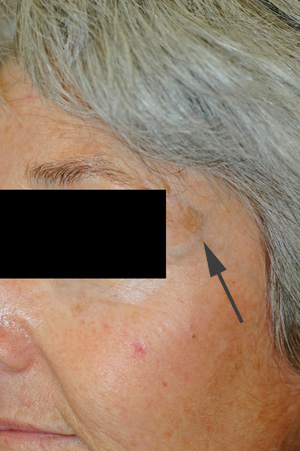
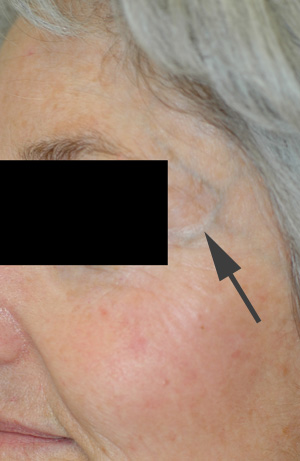
Liver Spot Removal Before and After Photos
Los Angeles Age Spot Removal Free Consultations
Are you seeing spots? Not in your eyes, but on the skin around them? If so, you may have syringoma. These are tiny, almost pinpoint, skin-colored bumps that pop up in your teens or twenties on the skin around and/or beneath your eyes. They don’t hurt and they typically don’t change with time, but unfortunately, they don’t go away on their own either.
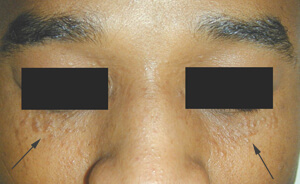
Women tend to get them more and often notice them when their under-eye concealer or makeup won’t hide them. Even though they’re harmless, most people with syringoma would like a way to remove them.
As of now, there are only two ways to effectively remove these: electrodessication and class IV medical lasers. Electrodessication uses a very fine needle that harnesses a small electrical current to “burn” or “zap” the syringoma. It is not always effective at removing them as it is highly dependent on the practitioner’s technical skill and experience with it.
The erbium micro laser peel is an ablative laser treatment that can more effectively remove the skin and glandular tissue of syringoma. It’s a very delicate procedure and extreme care is taken as we are treating the thin, sensitive skin of the eyelids. If you’re a candidate for treatment, it can be a great way to get rid of these unwelcome, unwanted spots around the eyes.
If you’re not sure exactly what a port wine stain is, then chances are you don’t have one. These are small to large, red or purple birthmarks that can be almost any shape and are commonly located on the face, although they can affect any part of the body. They are usually present at birth.
The color of a port wine stain comes from an overgrowth of capillaries in the affected skin. These extra capillaries aren’t needed for proper function, so port wine stains can be treated or “removed” with lasers without harming the skin at all. Class IV medical lasers are a great tool to remove these birthmarks.
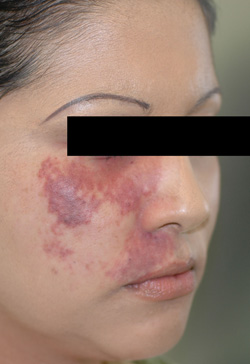
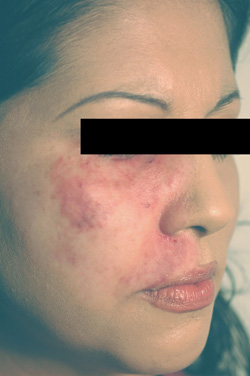
The specific type of laser that is used is the pulsed dye laser. It works by targeting the blood inside of the capillaries. The capillary walls are heated by the energy of the laser and it triggers them to collapse or “coagulate”. This stops more blood from filling up the capillary and over time, it is reabsorbed by the body. With each laser treatment, more and more capillaries are removed and slowly, the port wine stain will begin to lighten and disappear. Successful treatment takes time; usually a series of 6 to 12 laser treatments is necessary to completely remove one.
Even today, pulsed dye laser treatment of port wine stains is still considered the best, “gold standard” treatment available. For someone affected with this birthmark, the results are often life changing.
Have your legs officially gone into hiding? Are you embarrassed or worried about the appearance of spider veins? If so, you’re not alone. This is a common problem for about half of all people over the age of 50.
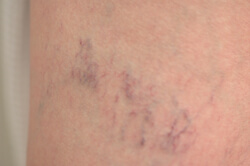
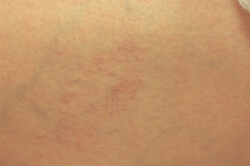
The medical term for small veins is “telangectasias”. Spider veins is a descriptive term because these blood vessels often look like a tangled mass of fine threads, much like a spider’s web. Unlike larger varicose veins that bulge out above the skin’s surface, spider veins are flat and even with your skin.
So, what exactly causes spider veins? There are many factors that increase your risk for spider veins, and pregnancy, obesity, or being on your feet all the time are just a few. The biggest influence is genetics. If they run in your family, then you’re likely to develop them.
Leg veins are designed to function like a one-way road: blood is supplied to the legs via the arteries and is supposed to flow back up through your leg veins to your heart and lungs. The blood return to the heart occurs against the pull of gravity. To counteract gravity,, your leg veins have a series of one-way valves that keep the blood from settling downward. Genetics can make these valves “leaky.” When this happens, blood flows in the opposite direction that it’s supposed to, pressure increases, and the veins become larger and more visible.
Spider veins can also show up on your face (cheeks and nose are common).In the face, these changes are often triggered by sun damage which causes the capillaries to enlarge and your skin to thin. Spider veins on the face are not related to the valve problems we discussed above.
Spider veins are rarely a medical problem, but more often a cosmetic concern. Luckily, good treatments exist! Class IV medical lasers offer you great results with little discomfort or downtime. These lasers can be used anywhere on the body and are safe for any skin type (color). While you might need a series of treatments to get rid of all your unwanted spider veins, laser treatment is very effective and gives most people amazing results.
It certainly can be. And until the advent of laser technology, there simply wasn’t an effective option to help people who had unwanted brown birthmarks. An important part of understanding what birthmark laser treatment can do for you is to have the right expectations.
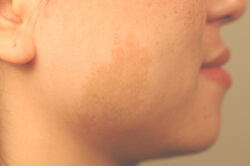
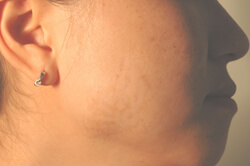 Just like the variety you see in birthmarks (colors, sizes, shapes, location), the results can vary from person to person too. Unfortunately, we can’t predict who will have complete removal of their birthmark versus significant fading. We also see rare cases where after successful laser treatment of an unwanted birthmark, it returns. This usually happens within the first one to three years following treatment, and the most common factor among those who experience this is sun exposure.
Just like the variety you see in birthmarks (colors, sizes, shapes, location), the results can vary from person to person too. Unfortunately, we can’t predict who will have complete removal of their birthmark versus significant fading. We also see rare cases where after successful laser treatment of an unwanted birthmark, it returns. This usually happens within the first one to three years following treatment, and the most common factor among those who experience this is sun exposure.
We let our patients know that it’s difficult to predict exactly how many treatments it will take to see optimal results. This is because the pigment in the skin may be at several different levels. We counsel our patients that treatment of birthmarks with laser removal is very individualized. Improvement after each session can help us better determine your response to treatment, but it may take some time to see how effective the laser treatment will be for you and better give us an idea of how many sessions it will take.
Lastly, our practice has only licensed nurses, nurse practitioners, physician assistants and physicians who evaluate and perform laser birthmark removal. Always have your birthmark evaluated by a licensed medical professional before you start laser birthmark removal. A crucial part of successful treatment of any condition is having the proper diagnosis from the start.
Celibre uses q-switched and Erbium fractionated laser technology to treat pigmented birthmarks. These lasers are safe for any skin type (color), and treatments generally take less than 10 minutes.
If you have a brown birthmark, we have an option for removal. We’ve helped thousands of patients with their birthmark and we can help you. Through our extensive experience, we’ve honed our skills, knowledge and expertise in this area. We can help you decide if pursuing laser treatment for your birthmark is the right choice for you.
That tattoo that seemed like a good idea at the moment may not feel like such a good idea at a later time. If and when that becomes the case, class IV medical lasers offer a good option for long awaited tattoo removal.
The laser technology is fascinating and quite advanced. By using high powered, “Q-Switched lasers”, we are able to actually fragment the tattoo ink particles, breaking them apart. In this way that the body’s lymphatic system can then absorb and process the pigment over next several weeks.
All skin types (light to dark-skinned) can have their tattoos removed with lasers.
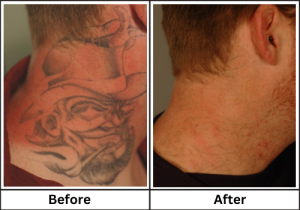
No. There are many factors involved in determining how quickly a tattoo will respond to laser tattoo removal treatments. Although some patients believe that their older tattoos should be less challenging, the ink has already faded (something the body and sun exposure does over time regardless of laser treatments) which makes it more challenging to find the right energy for the ink to respond to while being safe at the same time. Newer, professional tattoos tend to have higher quality, more dense ink which may require many treatments to obtain good results. Very new tattoos are treatable as long as the area has completely healed. Sometimes, very new tattoos obtain excellent results because treatments begin before ink has begun to shift in the skin/tissue.
Yes. Often, patients are not aware of what type of ink or substance was used when they received the tattoo. Certain ink (ex: Indian ink) may represent more of a challenge or can resolve more quickly than expected. The number of treatments required for laser tattoo removal is variable and has a lot to do with the type of ink that was used.
Most colors are treatable with the correct laser wavelength and the correct fluence (energy) with dark ink being the least challenging. The patient’s skin type also determines what treatment settings are safe and appropriate. Colors that are challenging are purple, yellow, and orange. Red pigment is treatable with a shorter laser wavelength which may represent a risk to those patients that are dark-skinned. Colors that are difficult and may not be treatable with current laser technology are those that lack enough pigment such as peach and white.
Yes – there is no way getting around that fact. Most patients will say that the treatment hurts as much or more removing the tattoo versus having it put on. However, the positive to this is that the laser treatment is generally very fast – much more so than having the tattoo put on. At Celibre, we offer two forms of numbing cream as well as a machine that provides very cold air to the area during treatment. Any discomfort ends when the treatment ends.
At Celibre, our protocol is to wait six weeks between treatments to allow for complete healing. Also, research supports that it generally requires six weeks for the body’s lymphatic system to completely clear the fragmented ink from the treated area. Performing treatments any sooner is not advisable as the laser may be treating the same ink particles that have yet not cleared from the area. We believe that following this protocol is in the best interest of our patients.
A common belief is that the tattoo will fade consistently and uniformly. On the contrary, pigment will fade quickly in some areas but may take longer in others. A “breaking up” of the pigment is usually what is observed initially. Each treatment should render slow but progressive progress. Using photos throughout the process will offer encouragement that things are moving forward.
This is a frequent question because patients do not fully understand the process of laser tattoo removal. The length of time required to receive optimal results is in part due to treatments being spaced six weeks apart. Some patients request to have treatments more frequently, but this would not only be unsafe, but a waste of their time and money. Another misconception is that by turning up the energy to its highest setting – the results will be accelerated. Not only does this not offer a more effective treatment but actually causing more harm to the epidermis, increasing the potential for scarring. A good practitioner will use effective but safe settings with each and every treatment. There are very specific skin and tissue reactions that the nurse or physician observes to be confident that the appropriate outcome is achieved.
What the patient does at home is extremely important in minimizing potential adverse outcomes. Wearing sunscreen daily to the treated area is mandatory while receiving laser treatments in order to minimize any discoloration to this area. Complete sun avoidance is necessary during the healing phase following each treatment which is generally less than a week. Keeping the area protected by clothing or a bandage will easily accomplish this during the short time of healing. Blistering following a treatment is not a desirable endpoint but is sometimes unavoidable. Not picking at the healing skin will minimize the risk for scarring. Sometimes, a lightening of the treated area (hypopigmentation) is observed. Although this is not common, it is necessary to avoid treatments to this area as well as sun exposure in order to allow the body to repigment the skin.
It is difficult for the laser tattoo removal practitioner to predict the number of treatments required for optimal results because there is no way to determine how the ink will respond. A wide range in the number of treatments should be expected such as six to ten or more treatments. By using the term “optimal results”, it is suggested that there may be a point wherein the tattoo ink is no longer responding even at the highest energy/fluence available. A correct, realistic expectation should be dramatic fading if not complete resolution.
At Celibre, we believe in setting the correct expectations by offering necessary patient education and involvement in the process. Our nursing staff is highly trained in delivering effective yet safe treatments for all skin types. We utilize the most advanced Q-Switched lasers for laser tattoo removal, and we stay on the forefront of research for all of the services that we offer. Visit celibre.com/tattoos for more information.
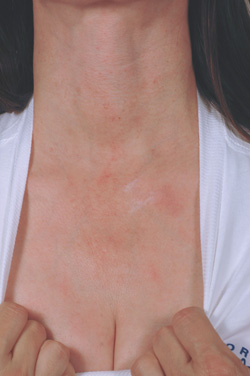
Poikiloderma is a term that is used to describe sun damage (photo-damage or photo-aging) to the sides of the neck and chest area. Photo-damage leads to brown and red discoloration that gives a rough or ruddy appearance to the skin on the chest.
As the texture of the skin on their chest changes, our female patients complain of a leathery look and feel to the skin. This leathery feel, combined with brown and/or red damage is what is commonly referred to as Poikiloderma.
Usually, a combination of lasers is used for effective Poikiloderma treatments. One laser is for redness while another is for brown sun damage. The patient’s skin type (color) is an important factor in determining how many laser treatments may be required for optimal poikiloderma results.
Some skin types are safe for aggressive pulsed dye laser treatments whereas others are more safely treated with non-aggressive treatments. Generally speaking, most patients receive good outcomes with a minimum of 6 “no downtime” treatments.
This is a question that we hear all the time from our patients! We think it’s great that more and more people are forgoing the tanning bed and the sun and opting for the much safer choice of a self-tan instead. Although it may be the safer choice regarding your risk of developing skin cancer, it still isn’t safe to have a fake tan and do any type of laser treatment.
Even though self-tanning and suntans are totally different, a laser cannot differentiate the two. Here’s why: self-tanners basically work by depositing a “stain” into the very top layers of your skin. A real tan (from the sun or artificial UV light) develops when your pigment cells, or melanocytes, are stimulated by UV light to make more melanin or pigment, gradually darkening the color of your skin over time.
Totally different, right? Yes, but lasers work by targeting excess melanin – which is why they work for removing hair, sun spots or scars which all contain it. Obviously, you don’t want a natural tan during this process as the excess melanin in the skin competes with the melanin in what you want to remove with the laser. The “color” or “stain” of the self-tanner however, can do exactly the same thing. Even though it’s not melanin, laser technology is just not smart enough yet to be able to distinguish the two and tell the difference. When too much laser energy is concentrated into the upper layers of skin, a burn can develop. This can lead to unwanted scars and darker discoloration.
We always complement our patients who’ve given up the sun for good. It can be really hard, but in the end, your skin will thank you for it. But if you’re considering having a laser procedure, you will need to avoid all self-tanners for at least two weeks prior to your treatment. This gives you enough time to completely fade (or exfoliate) anything that’s there and ensures that you have the safest, most effective laser treatment possible.
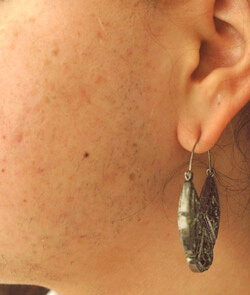
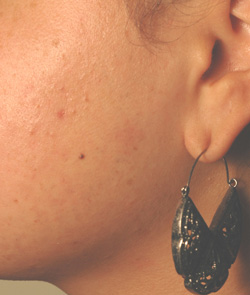
Laser hair removal before and after pictures
Lori Ishii Haney, RN, MEP-C
Certified Medical Laser Safety Officer
Laser dermatology is a relatively young, but quickly growing field. Until about 2005, it may have been difficult to find a “laser center” that offered multiple different laser technologies and procedures. But, if you’re thinking that practicing laser medicine is “easy” since everyone’s doing it…. think again! Laser medicine requires a significant amount of training and knowledge as well as numerous different devices to do it well and get it right. Laser physics is complicated, and for many practitioners, very confusing. At Celibre, it’s what we do best.
We believe that the foundation for a successful laser dermatology practice is educating you. We’ve created this page to help you better understand the principals involved in laser treatments. We understand that it’s confusing and we also know there is a lot of misinformation out there—both on the internet and at laser dermatology practices. So, let’s talk a bit about what lasers are and why they work on so many different types of skin problems.
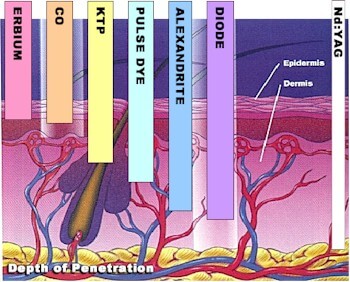
Lasers use light energy. Without going too far back to high school physics, remember that light travels in waves. Each color of light has a specific, unique wavelength. Visible light (the rainbow) is a range or spectrum of wavelengths that when reflected off an object hit the back of our eye (the retina) and are translated to a “color” by our brain. There are laser wavelengths that we cannot see as well. Examples would be infrared and ultraviolet light. These wavelengths are outside of the range of what the human eye (and brain) can see. Together, all wavelengths are called the electromagnetic spectrum.
Now, back to lasers. The reason dermatology lasers are so powerful is because each device is designed to utilize and amplify one, single type of light. This is also why lasers work to target one, particular type of skin problem.
For example, a certain type of orange light has a wavelength of 590 nanometers (590 billionths of a meter) and it is highly attracted to hemoglobin, the part of your red blood cells that binds to oxygen. Pulsed dye lasers use this wavelength of light to treat various skin conditions that involve unwanted blood vessels like Rosacea or vascular (red) birthmarks like Port Wine Stains. Because this light energy is preferentially absorbed by unwanted blood vessels, it does not affect the rest of the skin.
The idea of specifically targeting single structures (like melanin, hemoglobin or water) with single wavelengths of light is known as “selective photothermolysis”. This is the basis of all laser medicine, and explains why a laser dermatology practice really needs multiple, different devices to really provide a broad range of effective laser services for a variety of skin conditions. Each laser (ideally) should be good at treating one or two different but related conditions.
At Celibre Medical, we use over 20 different laser devices to treat almost any cosmetic skin condition. We choose only the very best device for your unwanted skin condition, and our practitioners have years of expertise with each of our lasers.
There is no “one-size-fits-all” approach to laser medicine, so be wary of a facility that claims it can treat “anything” effectively, but only has one or two lasers. Armed with a very basic knowledge of laser medicine, you can better decide with practice offers the technology and specification that you’re looking for to best help you with your skin.
It is a proven fact that our skin and tissue continues to respond and improve even when laser treatments have finished. This is based on a known theory called “the lag effect.”
The lag effect refers to how our bodies continue to make collagen to improve the texture of the skin after the laser treatments have finished. The same improvement over time is true in regard to pigmented acne scars that are red or brown. Research and experience shows that the lag effect in response to laser treatments may be as long as six months after the last laser treatment. Although much hard work occurs during the treatment plan, our bodies continue to hear after the laser treatment program has ended.
While laser technology is certainly compelling and fascinating, so too is the body’s amazing ability to heal. Time and lag effect – a good combination. See below for a visual presentation of the “lag effect” with tattoo removal procedures.
As experts in laser hair removal, we can tell you that not all laser hair removal programs are equal. At Celibre Medical, we have developed proven, effective laser hair removal treatment programs that allow our patients to enjoy between a 75% and 95% permanent reduction of their unwanted hair. In our experience, this level of hair removal is usually achieved after 6 to 8 treatments.
We’ve developed some common recommendations that we give to each patient to help get the most out of their laser hair removal treatment. We ask that you keep all your regularly scheduled appointments, to stay on the correct time interval between treatments. We also ask that you shave to removal unwanted hair during your treatment. Plucking or waxing removes the hair from the follicle, so that laser becomes much less effective at damaging it.
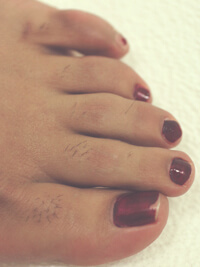
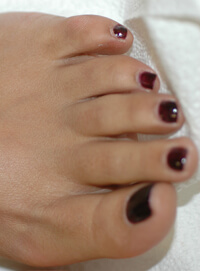
Permanent Laser Hair Removal Before and After Pictures
While most patients enjoy excellent results in 6 to 8 treatments, some see the same level of improvement after only 4 treatment sessions. The bottom line is that there is some variability, but if you’re not seeing a significant reduction in the amount of hair after 2-3 visits at your practitioner’s office, it may be time to switch. And if you’re pressured to sign up for a 6 or 8 treatment “package”, resist the urge. If you sign up with the wrong practitioner, you may not be able to get a refund.
Finally, we have identified a few different factors that may lead to more than the recommended number of treatment sessions. Hormone imbalances (like PCOD) and fine hair or hair that is light brown (not dark brown or black) will usually require more treatment sessions to get optimal results. We have also found that certain ethnic groups generally require more treatment sessions as do large areas, like the back or the legs.
We believe in being up front with our patients and educating them thoroughly about their procedure prior to beginning treatment. We’ve found that preparing you for the road ahead not only makes for a happier ride, but also gives you greater satisfaction at the end.
We know that trying to make heads or tails of all the laser information out there can be difficult if not impossible for the average person. The recent advances and breakthroughs in laser medicine are amazing and the number of devices and the companies that market them has skyrocketed in recent years. One of our guiding principles is patient education. We believe in providing the highest level of patient care, and to accomplish that, educate our patients on all aspects of their care.
One of the most frequently asked questions that reinforces our dedication to this end is what are the main differences between [laser A] and [laser B]? And often, as is the case with Coolbeam or “Cool laser” as it’s also called, we often educate our patients about devices that we don’t use ourselves. To discuss this device with our patients, we sought out a local provider that uses it to have them educate us on what it is, how it works and what its used for.
The Coolbeam laser is a type of fractionated erbium laser used for resurfacing the skin in procedures such as facial rejuvenation, stretch mark removal and improving acne scars. A similar laser that we use at Celibre is the Sciton Profractional. It is also a fractionated erbium laser that we’ve used successfully to treat many of the same conditions.
Since we’ve never actually laid hands on a Coolbeam laser, we can’t discuss the subtle differences between it and our Sciton laser. But since the two are very similar technologies that use the same type of energy source, they are fundamentally very alike. We can discuss the results that we’ve achieved with the Sciton laser and share some actual patient photos with you like those on this page. As you can see, it’s very effective for the treatment of unwanted acne scarring.
Whichever device you choose for your treatment, make sure that you ask about the technology itself in addition to the cost. Understanding the potential risks and benefits of any procedure along with what you can expect in terms of improvement and downtime will go a long way toward being happy with your treatment!
Millions of American adults like you suffer daily with the embarrassing redness and acne-like breakouts of Rosacea. It’s a common skin condition that usually affects those with fair skin types. Although many different oral and topical prescriptions exist for the treatment of Rosacea, none is 100% effective. Rosacea is incurable, so even if a treatment works, it can come right back. If this all sounds familiar to you, then we’d like to talk to you about a different Rosacea treatment option: pulsed dye lasers.
If you’re tired of dealing with the uncertainty of Rosacea, or if you’ve failed multiple different prescription treatments in the past, then lasers may offer you the relief and improvement you’ve been looking for. They can be an effective treatment tool no matter how bad your Rosacea is or what you’ve tried and failed in the past. Sometimes, they offer long-term relief from the daily flushing, redness and breakouts of Rosacea. Here’s how they work: pulsed dye lasers are the tool of choice for treating Rosacea. They target hemoglobin, which carries oxygen and is responsible for the red color of blood.

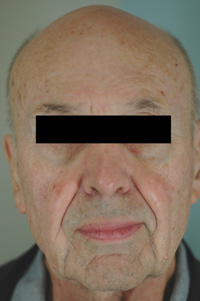
Rosacea before and after photos
The typical symptoms and facial appearance of Rosacea develop due to too many enlarged and dilated facial blood vessels in the skin. This laser effectively targets these numerous vessels and heats them up quickly, causing them to collapse. Once this happens, the treated blood vessel can’t fill back up; it slowly breaks down and then is reabsorbed naturally by the body. The end result is less blood vessels, less redness and clearer skin.
In addition to getting rid of the excessive, non-essential blood vessels, the pulsed dye laser also gently heats the skin, triggering some collagen and elastin remolding and stimulation. This equates to smoother, tighter skin with each treatment. Also, Rosacea itself can trigger textural skin changes that can be improved with these laser treatments. No topical prescription cream can do that!
Rosacea laser treatments are typically spaced 4 to 6 weeks apart to allow for sufficient healing. Depending on the severity of your Rosacea, you may need 4 to 8 treatment sessions to get the improvement you’re looking for. Although these treatments are most often not covered by medical insurance, our patients tell us that they are well worth the investment because of both the physical relief and cosmetic improvement they provide.
Here at Celibre Medical, this is a common question. We hear it from our patients nearly every day! And while the question is nearly the same from everyone who asks it, the answer isn’t. The preferred question to ask is, “Am I a good candidate for laser treatment of my stretch marks?” This one is a bit easier to answer based on what your stretch marks look like.
We want our patients to be satisfied with their treatment—better yet, we want them to be ecstatic with their results. A huge part of our ability to do this lies with picking and choosing patients who are good candidates for the laser procedures that we provide. We will not promise results that aren’t realistic or that we know we can’t deliver on. As laser experts, we use our knowledge and expertise to determine who will respond to treatment and who won’t. While we wish we could treat each and every stretch mark with lasers and make them go away, we know that we can’t (at least not yet!).
So, who is a good candidate? Someone who is younger, with newer or more recent stretch marks that are red, pink or brown in color. We also tend to have success with stretch marks that are more indented or sunken in—not flat. In general, flat (or raised), white stretch marks do not respond well to laser treatment. So, as you can see, answering this question really depends more on the qualities of your stretch marks than it does the laser.
Also, in many cases, you can expect improvement in the appearance of your stretch marks after laser treatment, but not 100% clearance. We always discuss this up front with you, and never after your treatment. We know a huge part of our success and your satisfaction depends on what expectations you have for your laser treatment. We will take the time to discuss this carefully with you to ensure that everyone’s on the same page.
The name of our game is to under promise and over deliver. This is a fine line to walk, but we are very good at it; it’s helped us become one of the most trusted laser dermatology practices in the Los Angeles and torrance area.

